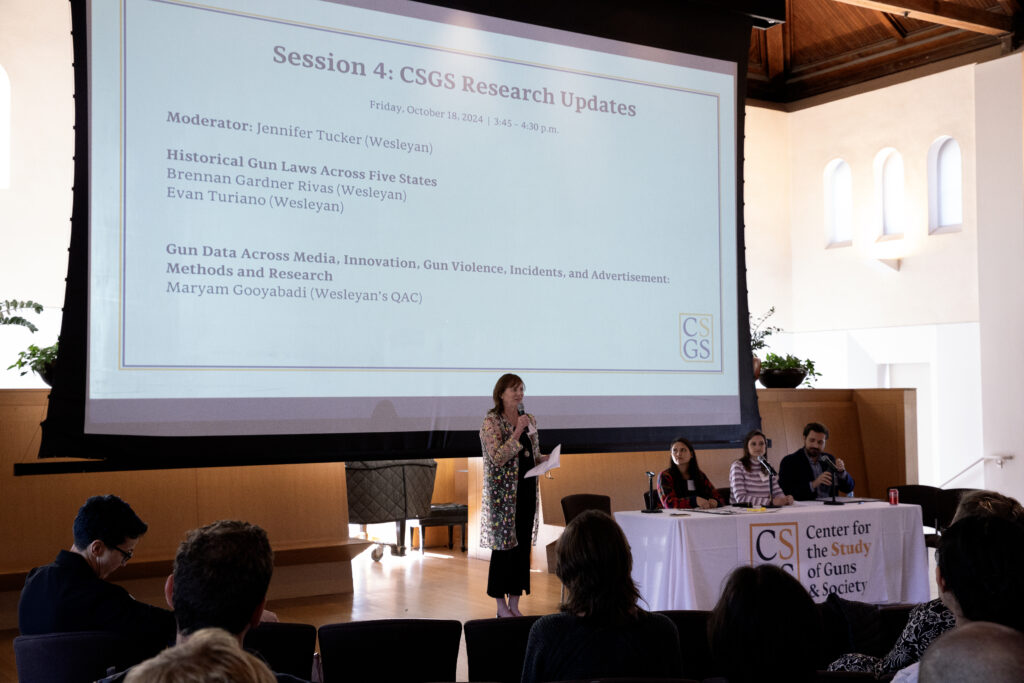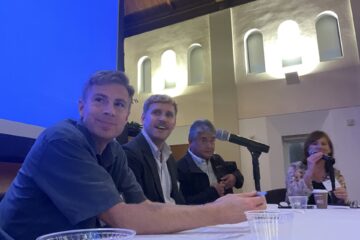
More than 100 scholars, practitioners, and students from across the academic spectrum gathered Oct. 18 and 19 for the Center for the Study of Guns & Society’s (CSGS) annual fall conference at Wesleyan University. The cross-disciplinary summit featured presentations by historians, lawyers, curators, filmmakers, and public health experts, all focused on better understanding the role of firearms in American life.
“When we think of the subject of guns as a tug-of-war between two groups, that reinforces artificial binarism. Without a more comprehensive understanding of the subject, the conversation on guns risks remaining mired in oversimplified messaging,” says Jennifer Tucker, Professor of History at Wesleyan and founding director of CSGS. “My goal for this conference was to bring together diverse perspectives and many areas of research on the topic.”
“The wealth of expertise called forth by the Center here meant that I learned more in two days than I could gather in a year of reading,” said Justin A. Joyce, Managing Editor of the James Baldwin Review at Washington University in St. Louis.
The October gathering marked the third annual fall conference hosted by CSGS since its founding in April 2022. CSGS is the first academic center in the U.S. dedicated to interdisciplinary humanities study and teaching on the social and cultural history of firearms. The Center hosts a robust lineup of programming throughout the year, along with a diverse range of undergraduate course offerings and research opportunities.
“This conference brought together a vital mixture of stakeholders and academics—just what our nation needs as we confront the substantial changes to Second Amendment law,” said Ian Ayres, the Oscar M. Ruebhausen Professor at Yale Law School. Ayres appeared in a Friday panel discussion, “Guns in the Age of Originalism,” alongside the Pulitzer Prize-winning Stanford University Professor Emeritus Jack Rakove; Mark Frassetto, Deputy Director of Second Amendment History and Scholarship at Everytown for Gun Safety; and Kelly Roskam, Director of Law and Policy at the Johns Hopkins Center for Gun Violence Solutions.
“[The conference’s] topics covered everything from the changing legal environment in the confusing aftermath of the Bruen and Rahimi decisions to the use of firearms by women working in the sex trade, tests on the lethality of different weapons, how one maintains safety on movie sets, and much more,” Rakove said.
A highlight of the conference was a Friday panel discussion, “Gunplay and Movies,” featuring Henry Lu, a Hollywood armorer and weapons handler.
“Ideas about gun use often come not from history books, but from film, TV, anime, and video games, so it’s important to talk to people in the industry about their craft and perspectives,” Tucker says.
Lu, who has worked on blockbuster films including Terminator 2, Waterworld, and The Pirates of the Caribbean, spoke about the details of his craft and how he works to ensure safety on set while meeting a director’s artistic needs. He also met with Wesleyan students in the class “Visualizing Firearms History: A Project-Based Exploration.”
“I enjoyed the unique opportunity to share my experience on the use of firearms in the film industry. Their common presence in films plays a role in shaping diverse narratives,” Lu said.
The conference also highlighted several research projects supported by CSGS and underwritten by the National Endowment for the Humanities, the Mellon Foundation, and Arnold Ventures, among other funders.
CSGS postdoctoral fellows Evan Turiano and Brennan Gardner Rivas discussed their exhaustive archival work to gather and analyze pre-1930 state and local firearms regulations in five states. Steven Hargarten, Professor of Emergency Medicine at the Medical College of Wisconsin presented findings from ballistics testing experiments, which are designed to document critical elements of a bullet’s “behavior” in analogues to human tissue.
Read more about the conference proceedings in the selected Presentation Summaries at the end of this article.
“[The conference] was enriching and challenging in ways I couldn’t have anticipated,” said LK Bertram, Associate Professor of History at the University of Toronto. “It was an example of how to build strong, effective interdisciplinary conversations on pressing issues.”
The undergraduates in attendance also appreciated the conference’s unique blend of perspectives on the role of guns in society. “This was my first time attending an academic conference, and I was honored to be able to meet so many experts in the field of firearms research,” said Wesleyan student Sonya Drake. “I really got an idea of the breadth of the research that’s being conducted by scholars across the country.”
In addition to the presentations and panels, conference attendees took a walking tour of gun manufacturing sites in New England hosted by the Middlesex County (Conn.) Historical Society. Attendees also enjoyed networking with one another between sessions, including at CSGS’ new headquarters on the Wesleyan campus. Horgan House, a renovated carriage house that dates to the 1880s, features a seminar room, kitchen, library, and offices for Wesleyan-based and visiting scholars to use.
“It’s rewarding to know that our participants felt that this conference was generative, exposing them to the breadth and depth of this field and pointing them in new directions of study about the role guns play in modern American life,” Tucker said.
CSGS’ annual spring symposium for undergraduates will be held in April 2025 (specific dates forthcoming). The 2025 annual fall conference is scheduled for Oct. 10-11. Both conferences will be held at Wesleyan University.
Click here for additional presentation summaries.
Click here to see conference photos.
